Foreword
This thread is meant as an introduction to periodisation. Too often, I have seen people who didn't understand the foundations of training, so I decided to fix this situation.
Obviously, I will need to keep many details out for sake of simplicity. Periodisation has filled hundreds of thousands of pages, and is the main subject of 3-4 yrs university kinesiology programs. I will try to keep it as simple as possible, and this is why I will use as many graphs as I can to better illustrate concepts.
I have worked for quite a long time to come up with the simplest way to explain and illustrate these concepts. This ended up being much longer than I expected . This is definitely a long read, but I think it is worth reading it. I hope you will enjoy it. I am totally open to comments, suggestions and questions; however, please refrain from sending me PM asking for a training program, as it could quickly get out of control (I wouldn't have the time, and I would have to ask for financial incentives for my work).
I chose to post this thread in the powerlifting section rather than the Exercises or Workout programs sections, as this is more likely to interest elite or wannabe-elite lifters than the average gym-goer.
Finally, I had a previous thread about muscle strength, feel free to read it to refresh your knowledge on what makes a muscle strong:
http://forum.bodybuilding.com/showthread.php?t=6093771
1. The basic principles of training: Theories of training
The theory of training has defined many theorical principles of training. Most of them do not need to be covered here. I use the word "principle" as a vague term that may not have the same signification as what would normally be taught.
1.1 The principle of overcompensation
When you train, you become weaker, less performant in your sport. You then recover, and eventually become better: that's overcompensation.
Figure A: overcompensation
The middle line represent a state of homeostasis, a state where there is no improvement. After the maximum peak of overcompensation, comes a state of involution, where performance gradually goes back to a state of homeostasis.
In the next picture below, you can see I draw 3 different lines; these reflect the effects 3 different loads of training would have on performance and recovery. Notice how all 3 lines have approximately the same training duration; the difference is in the speed of recovery, and the training effect (depth of load versus height of overcompensation curve).
Figure B: Different training loads
It becomes clear that the best time to train would be at the moment of the highest peak of overcompensation. This is not always possible, but we should be as close as possible to it. Over a longer time period, this would result in this:
Figure C: Gradual increase in performance
As you can see, even though we can't always have totally recovered in time for the next training, the cumulative effect will still result in a gradual increase in performance. Notice how the curve is not a "perfect sequence" of overcompensation. We should still strive for overcompensation, since overlooking this concept would result in the dreaded effect of overtraining:
Figure D: Gradual decrease in performance
1.2 Different ways to stress your body
There are 4 components in training load (3 are often taught, I add a 4th one).
- Duration: how long the training actually lasts. A concept that is also used in strength sports is volume: it would be expressed as number of sets and reps rather than hours.
- Frequency: how often you train during the week;
- Intensity: This is often expressed in % of your max. You would be approximately at 80% of your max when you do sets of 8 reps (RM), and you would be at about 90% when doing sets of 4 reps.
- Density: This one is not usually taught as a load component, but I like to include it: it refers to the amount of time spent resting between sets. It is therefore only applicable to strength sports. If you lift for 60 seconds, then take a 180 sec. rest, your total density would be 25%.
1.3 Different "spheres" of load in training
Not all your body is stressed the same way depending on the type of training you do; the different spheres are:
- endocrinal: a good example is the effect of training on testosterone and cortisol; testosterone is high at the beginning of training, and gradually decreases. The reverse is true for cortisol.
- metabolic/muscular: energy production (ATP synthesis, etc.), muscle recovery. Recovery from this type of stress is quick, except maybe in the case of DOMS (Delayed Onset Muscle Soreness: where tiny muscle tears appear everywhere in the affected muscle). ATP/CP is replenished in a few minutes, lactic acid is cleared within an hour, and glycogen can be replenished within 24-36 hours.
- CNS (neuro-psychological): this stress is particularly present in competition, where mind games can be played.
- CNS (neuro-muscular): this is the biggest stress when weight training. Neuro-muscular recovery is 7 to 11 times slower than metabolic/muscular recovery. Nervous cells tend to adopt a state of inhibition for quite a few hours after heavy load.
- cardio-pulmonary: this is particularly present in cardio-vascular sports, such as cycling, running, etc.
1.4 Different ways to measure performance
Performance can be measured through 4 criterias: speed, strength, flexibility, endurance.
- In powerlifting, strength is the most important, speed is just a bonus; in olympic lifting, both speed and strength are important. In both case, a minimum level of flexibility is important.
- In cycling, long distance running, xc skiing, endurance is the most important.
- In sprinting sports, speed and strength provide power.
- etc. etc.
1.5 The principle of progressive increase of load in training
This one might appear as a no-brainer. Unfortunately, it is probably the most misunderstood principle of all. In weight training sports, we will naturally have a tendency to increase the load by increasing the weights, as we get stronger. Even though you are stronger, this still result in a higher stress on the neuro-muscular sphere. But, as discussed in section 1.2, you can also increase the load by increasing duration, frequency and density.
Increase your training load too quickly, and your body will not have time to adapt, and you will reach a state of overtraining.
(continued in next post...)
|
|
-
03-10-2008, 06:01 PM #1
Everything you always wanted to know about periodisation, but never dared to ask
Last edited by The_cannibal; 03-11-2008 at 11:20 AM. Reason: proof reading

-
03-10-2008, 06:02 PM #2
2. Methodology of training
2.1 The principle of planning in training
As we saw earlier, recovery is essential for adequate performance. However, complete recovery after a hard day of training may last more than 48 hours, and training every other day is not really an option for elite performance. That's why we must alternate easy days with hard days, as illustrated below:
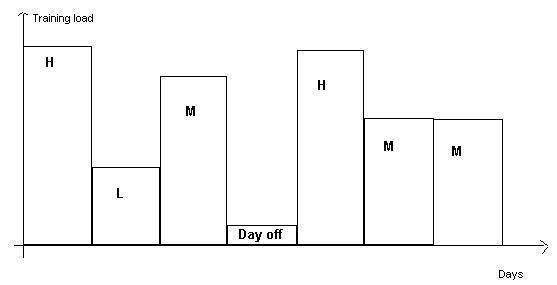
Figure E: Microcyle
Each rectangle represent one day. H represent hard days, M: medium days, L: easy days, and we plan a day off on the fourth day. There are many ways to alternate harder days with easier days. A harder week would have more hard and medium days, and less easy days, etc. A week like this is usually called a microcycle.
In order to progressively increase the load in training (section 1.5), we have to plan harder and easier weeks; we plan a macrocycle:
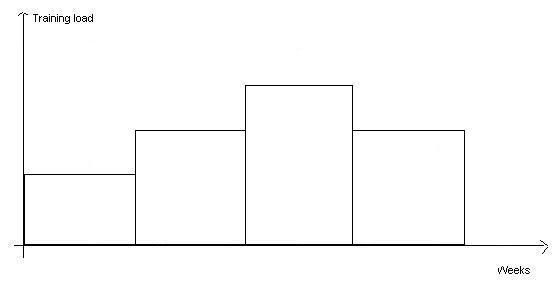
Figure F: Macrocycle
This is the typical macrocycle: 3 gradual increases in load, followed by an easier week. As seen in section 1.2, the load of training can be varied with duration, frequency, intensity and density.
Over a longer period, this is how macrocycles would add up:
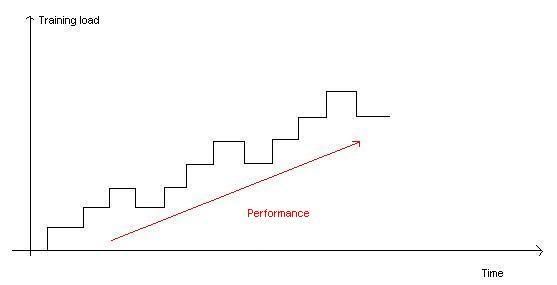
Figure G: Gradual increase in load and performance
If well planned, then performance would gradually increase.
2.2 Annual Periodisation
You can't use high volume and high intensity at the same time. However, both are important to maximize performance. This is where annual periodisation comes in: we can split the year in different periods with different focuses.
Here is an annual "plan" for a powerlifter with one major competition at the end of the year (MS Paint isn't exactly the best software to build graphs):

Figure H: Annual plan 1
We have a deloading period at the end of the year, which is followed by adaptation training at the beginning of the next year; this period is used to rehabilitate the tendons and all connective tissues into heavy training. The highest volume of the year is then seen during the hypertrophy period, where the athlete will develop myofibrillar and sarcoplasmic hypertrophy. The rest of the year will be used for maximum strength training, since this is the main goal of this sport.
An annual "plan" for a powerlifter with 2 major competitions, one mid-season, then one at the end of the year will be similar to the first one, but we would have 2 deloading periods, which would result in two peaks. The primary peak would be at the end of the season.
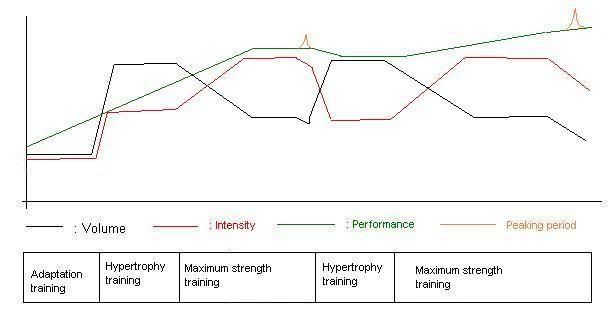
Figure I: Annual plan 2
Here is an annual "plan" for a bodybuilder with one major competition at the end of the year:
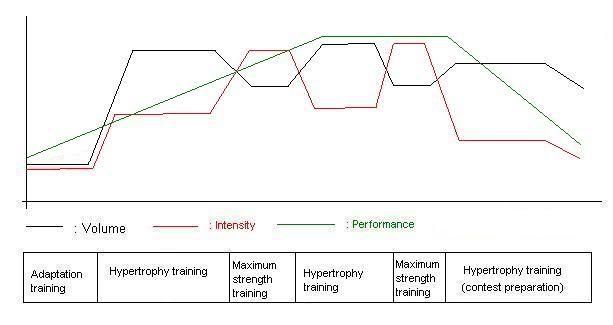
Figure J: Annual plan 3
For a bodybuilder, a peak represents a peak in conditioning, which is unrelated to lifting performance, so we do not program a peak, and we see a decrease in performance as dieting is used. Notice that hypertrophic training is much more prevalent, but maximum strength training is still used as a mean to promote myofibrillar hypertrophy, etc.
(continued in next post...)Last edited by The_cannibal; 03-11-2008 at 11:25 AM. Reason: proof reading

-
03-10-2008, 06:03 PM #3
3. A second look at overtraining
3.1 Misconceptions
"There is no overtraining, just undereating"
-- Trey Brewer, NPC competitor.
"I'd rather be 10% undertrained than 1% overtrained"
-- Michellie Jones, World class triathlete, world champion.
There is a gross misunderstaning of overtraining on this board, and this is why I decided to write a whole section on this subject.
The first quote is attributed to Trey Brewer. Trey is an amazing athlete with tremendous recovery capacities, we can also guess that he is on a lot of "ergogenic aids". Testosterone has often been linked in many studies to increase not only protein synthesis (nitrogen retention), but also improve neural adaptations. Eating properly can also improve recovery, but over-eating has never been linked to improved recovery. An athlete like Trey has such recovery capabilities that he has probably never even come close to overtraining; but make him train 10 hours a day at 80-90% intensity, and you'll obviously see a dramatic decrease in performance. Overtraining still exists: it just takes a whole lot more training for him to get in that state.
The second quote is much smarter. Triathletes, cyclists, xc skiers, runners, etc. are athletes using very high volumes of training. Intensity is usually not used more than 2-3 times a week. These athletes have to constantly monitor their performance and feelings in training to avoid overtraining. If you had to remember only one thing from this text, it would have to be Figure D: gradual decrease in performance from overtraining.
3.2 Overreaching
The definition of overtraining is "A prolonged state where training stimuli exceed the athlete's capacity to recover". Overreaching is about the same thing, but where this state is kept to a much shorter duration.
Only very experienced athlete should ever attempt overreaching. You have to know yourself very well, and be in total control of your training. I would personnally never recommend overreaching to a person with a family, a job, and a regular social life. All these factors can bring stress in one's life, which would go against the idea of total control that is needed to succeed in overreaching.
When the period of CONTROLLED overreaching is ended, a period of similar duration with much lower volume and intensity should be used. Overreaching can be used about a month prior to a major competition, in order to create a peak.
3.3 Signs of overtraining
- sensitive to criticism
- tendency to isolate oneself from coach and teammates
- lack of fighting power
- "fear" of competition
- lack of coordination, technical faults
- slower rate of recovery
- decrease in performance (10% +)
- prone to injuries/infections
- insomnia
- lack of appetite
- sweat very easily
4. A quick analysis of some generic training programs
A lot of "generic" training programs are posted on the Internet. Most of these are used by the average gym-goer as a mean of planning. In most cases, these methods can easily be integrated into a periodized annual training program.
Max-OT: Maximum Overload Training:
High intensity (4-6 reps, 90% of 1RM), low volume, medium frequency (normally 5 days/wk), low density (long rest periods between sets). This can fit very well into a maximum strength training period.
HST: Hypertrophy Specific Training:
Varying intensity, varying volume, varying frequency, medium density. This method applies a lot of periodisation principles. You vary the intensity by not always working to RM. This allows you to have 1 easy week, followed by a medium week, followed by a harder week. You work each muscle much more often than the usual training program. This is more geared towards bodybuilder than powerlifters.
HIT: High Intensity Training:
High intensity, low volume, low frequency, high density (short rests). This can fit well into a maximum strength training period, but it would better be used by a bodybuilder than a powerlifter because weights have to be lower because of the shorter rest periods.
GVT: German Volume Training:
Low intensity, high volume, high frequency, medium density. Described as brutally hard, it would fit well into a hypertrophy training phase; however, it shouldn't be used for extended periods since it may result in too mch stress.
Milos' giant sets:
Milos Sarcev, a retired IFBB pro bodybuilder, has been known to use extreme sets with his athletes. This is very low intensity (50% or less of 1 RM), very high volume, varying frequency, high density. One would use very low weights, and do 10 sets without rest, going from one machine to the next. All the machine used would target the same muscles. According to Milos, this creates a state of hyperenemia, which favorise muscle growth. I can only see this as adaptation training: it could be good for connective tissues.
Smolov:
This is a good example of overreaching. Obviously, noone would do Smolov for extended periods of time, and this is the way it is meant to be used. The warnings I mentionned in section 3.2 apply here: an inexperienced lifter would get more damage than improvement.
5. References and suggested reading
- Tudor O. Bompa, Lorenzo J. Cornacchia, Serious Strength Training, Human Kinetics Pub, 301 pp
- Tudor O. Bompa, Theory and Methodology of Training: The Key to Athletic Performance, Kendall Hunt Pub Co, 381 ppLast edited by The_cannibal; 03-11-2008 at 11:29 AM. Reason: proof reading

-
03-10-2008, 06:08 PM #4
-
-
03-10-2008, 06:10 PM #5
-
03-10-2008, 06:12 PM #6
-
03-10-2008, 06:47 PM #7
-
03-10-2008, 08:01 PM #8
Excellent post, it is rare to see meaningful contribution around here. I particularly liked section 2, "Methodology of Training." The macrocycle explanation was extremely clear and simple, but you effectively got the message across.
I had a question on section 1.2. I understand what you are illustrating in figure 1 and 2...however when you say "the best time to train would be at the highest peak of overcompensation," you are talking about a single workout to the next correct? I guess my problem with periodization has been understanding when I am truly peaking, and when I am still riding the wave of overcompensation. This is obviously important when training for a competition, or new set of training maxes...you don't want to miss your window, but at the same time you don't want to cut yourself short.
I guess I should include I just started using basic forms of periodization. I understand most of the basic theory, but I guess maybe its just going to take trial and error to successfully implement a lot of it.Last edited by JBElite; 03-10-2008 at 08:08 PM.
"Until later, may the wombat of happiness snuffle through your underbrush." - David Puddy (banned but not forgotten)
-
-
03-10-2008, 09:26 PM #9Registered User

- Join Date: Feb 2008
- Location: Glasgow, Scotland, United Kingdom (Great Britain)
- Age: 35
- Posts: 1,545
- Rep Power: 1587












REPPED!!! Absolute class post,

Poss future sticky "If you want to get your face beaten and well smashed, your ass kicked, and your arms broken, contact Carlos Gracie at this address..." - Brazillian newspaper ad circa 1920 - Now THATS alpha!!!
"If you want to get your face beaten and well smashed, your ass kicked, and your arms broken, contact Carlos Gracie at this address..." - Brazillian newspaper ad circa 1920 - Now THATS alpha!!!
My whipped ice dairy drink brings the attention of many males to my place of residence and/ or employment, and they declare that its quality far surpasses that of yours. Absolutely, it far surpasses yours. I could convey to you the recipe, but i would have to demand compensation.
-
03-11-2008, 08:33 AM #10
Thank you.
Thank you. That would be nice to see it as a sticky, but I think only mods or people with a lot of rep power ever see their threads turned into stickies.
No, but I've heard of it. That's the book by Rippetoe, isn't it? I've meant to learn about Rippetoe training methods for a little while. I'll check it out.
Yes, I was talking about one training to the next: training when fully overcompensated will optimize training effects. However, for a lot of people, the optimum overcompensation would not happen for 36-48 hours after a hard training. That's why I included figure C, which shows that you can sometimes miss the overcompensation wave, but as long as you take days off to recover, you'll still make gains by the end of the week.
In weight training, we are a bit lucky compared to other sports: we can train different body parts on different days (compare this with cycling, where you train nothing but the legs). This allows the muscles to recover, but the CNS is still taking a good "pounding". That's why it is good to have 1-2 days off during the week (unless you're a genetic freak).
The concept of season peaking is a bit different. I didn't explain much of it, because it was already getting pretty long (it takes about 10-15 minutes to read, I think). Figure H and I introduce very briefly the concept of season peaking (the little yellowish peak on top of the green performance curve).
Season peaking is really something special. When you are truly peaking, you really know it: it seems like your whole body is working seamlessly, your technique is perfect, your strength/speed/endurance (depending on the sport) is through the roof, you have good appetite, you sleep well, etc.
It is considered to be a "temporary state when physical and psychological efficiencies are maximized and where the levels of technical and tactical preparation are optimal. During this state of training, the individual's physiological and anatomical adaptation capacities are maximum as well, and the neuro-muscular coordination is perfect. Peaking is a superior, special biological state which is characterized by perfect health, optimal physilogical state expressed through a quick adaptability of training stimuli, and a very good rate of recovery following training and competition. The athlete's body reflects a high state of functional synergism (acting together) in which organs and systems are channelled in the direction of achieving optimum efficiency and, thus, the highest possible performance." -Bompa, 1994Last edited by The_cannibal; 03-11-2008 at 11:37 AM.

-
03-11-2008, 06:49 PM #11
-
03-11-2008, 06:51 PM #12
-
-
03-11-2008, 07:46 PM #13
-
03-11-2008, 08:43 PM #14Registered User

- Join Date: Oct 2007
- Location: Santa Cruz, California, United States
- Age: 38
- Posts: 5,504
- Rep Power: 5043












So reading this and looking at something like westside. I see how the principles apply on a weekly basis and changing exercises after two or three weeks(one for more advanced athletes) all seems to make sense. Does westside conflict with the idea that you should up the workload on a yearly basis towards two meets
Consistency
-
03-12-2008, 07:22 AM #15
To be honest, I am not the most knowledgable guy when it comes to Westside Barbell techniques. I know about their use of bands, chains, etc. and I know about the ME and DE days, which is all good stuff, but I have no idea what their view is on annual planning.
One thing I can tell you though: you can be sure that most olympic champion, no matter the discipline (from long distance running to oly lifting), have used some form of periodisation to get there. The theories of periodisation doesn't really get into the specifics of any sport, it just provides general guidelines to optimize gradual increases in performance.
In contrast, Westside provides very specific guidelines for powerlifting. I am sure that one could integrate Westside routines into a periodisation-oriented annual plan.
-
03-12-2008, 10:36 AM #16
Great post!
"At the cost of being repetitive, I have to once again state my amazement at the aspect of human nature that allows us to mix the most rigorous skepticism and the most acute gullibility"
"As drowned worshippers do not write histories of their experiences (it is better to be alive for that), so it is with the losers in history, whether people or ideas"
"Secular bull markets are designed to take the least amount of people along for the ride as possible, call it universal law."
-
-
03-12-2008, 06:39 PM #17
-
03-14-2008, 06:11 AM #18
-
03-14-2008, 06:53 AM #19Skinny bastid

- Join Date: Mar 2007
- Location: Massachusetts, United States
- Age: 43
- Posts: 1,174
- Rep Power: 242












Good read. Some thing puzzles me though :
So is this for the athletes training daily only? If you train 3 times a week you it is unlikely to hit overtraining?
As we saw earlier, recovery is essential for adequate performance. However, complete recovery after a hard day of training may last more than 48 hours, and training every other day is not really an option for elite performance. That's why we must alternate easy days with hard days, as illustrated below:
-
03-14-2008, 07:52 AM #20
If you train 3 times a week, you are much less likely to overtrain. Volume and frequency is low enough that you can keep your training intensity very high all the time. You do not need to alternate high volume with high intensity, since your volume is relatively low.
There is nothing wrong with low volume of training if you have other interests in life (personnally, my life sucks and nothing else matters in my life outside of training), but periodisation becomes much more important when you reach higher volume and frequency of training (5-6 days/wk, sometimes 2x per day).
Here are 3 examples of very high volume with very high frequency; the upper square represents AM training, the lower square represents PM training (I guarantee overtraining to anyone who tries that without PROGRESSIVE increase in load):
This is the 3+1 method:

This is the 5+1 method:

This is the 5+1+1 method:

Last edited by The_cannibal; 03-14-2008 at 08:31 AM.

-
-
03-14-2008, 04:46 PM #21
-
03-15-2008, 10:38 AM #22Registered User

- Join Date: Oct 2007
- Location: Santa Cruz, California, United States
- Age: 38
- Posts: 5,504
- Rep Power: 5043












So while at work the other day I was thinking about ways to incorporate this into a yearly plan. I like to change my workouts up to keep things fresh. This was just an idea I was spitballing for a yearly cycle. I really have no scientific knowledge or basis for any of this just sounded kind of in line with some stuff I've read including this. Please thrash this so I can know what is dumb as hell lol
Start of Year:
- Sheiko(6-61/2 weeks volume)
-Bench routine and russian 9 week routine for squat/dl(10 weeks volume)
-westside switching exercises every 3 weeks to reduce load(9 weeks)
also for RE exercises one exercise for each bodypart with 3 sets
- Sheiko(6-61/2 weeks volume)
-westside switching exercises every 3 weeks to reduce load(9 weeks)
also for RE exercises one exercise for each bodypart with 3 sets(possibly 4)
-westside switching exercises every 3 weeks to reduce load(9 weeks)
also for RE exercises one exercise for each bodypart with 4 sets(possibly 5)
-end of year total deload, extra weeks taken to fit peaking/deloading for meets in.
If anything this should hopefully at least generate some more discussion for this articleConsistency
-
03-15-2008, 11:24 AM #23
This sounds good. Of course, you always need to tailor every one of those programs to your own "needs". For example, if the original Sheiko program recommends a precise amount of volume, but you do not feel like you can take that much volume, then you should reduce it a bit.
One of the most important thing to remember is to avoid abrupt increases of load in training, whether increases in volume or intensity. I have done that mistake many times. I just have too much enthusiasm in training, and I always want to do more (what is the difference if I do 1-2 more sets of squat, right? ).
).
Now that you have defined the main lines of your annual plan, you can start planning your next macrocycle for the next 4 weeks. Then, at the end of each week, you prepare your next microcycle according to the way you have planned your macrocycle, while remaining aware of how your body responded to last week's training.
In a way, planning your training ahead of time becomes as much of an art as a science: I could go on and on for 500 pages on the science of training, but you still need to refine everything according to what your body tells you. That's why I enjoy self-coaching, because no coach could know me as well as I do after 20 years of training.
-
03-15-2008, 11:45 AM #24
-
-
03-15-2008, 11:48 AM #25Registered User

- Join Date: Oct 2007
- Location: Santa Cruz, California, United States
- Age: 38
- Posts: 5,504
- Rep Power: 5043












Thanks for the advice. Im getting a little better at knowing what my body should do I think. I used to just follow programs to a T(still do for the most part) but always tried to do a little more cuz I had the mindset that if I didn't push hard enough I wouldn't gain anything. Well that attitude got me pretty much no gains lol.
I will definitely be tailoring the westside weeks to my own needs but the one thing that I know I screwed up on in the last two weeks actually which you said was to not switch between high volume and high intensity too quickly. I'll definitely be tailoring a more gradual transition into my programsConsistency
-
03-15-2008, 06:06 PM #26
My plans are on paper, it would be too long to try to transfer them on a computer. Anyway, looking at someone else's planning wouldn't be of much help, since it has to be tailored to your own needs.
However, I can provide you guidelines on how to set up your own plan if you answer these questions:
1- How old are you?
2- What are your weight, height and approximate body fat %?
3- How long have you been training?
4- How long have you been training seriously?
5- How many hours a week do you wish to spend on your training?
6- How many times do you train in a week?
7- What is the maximum amount of time you wish to spend training per day (during phases with more volume)
a) on a weekday?
b) on a weekend day?
8- Can you train more than once a day? (if you work or are in school, the answer would most likely be 'No')
9- Do you train as :
a) a bodybuilder?
b) a powerlifter?
c) a strongman?
d) an olympic lifter?
10- Do you compete? If so, what is/are the competition(s) for which you wish to be at your best (mention the date)? How long have you been competing?
11- What are your best lifts? If you are a bb'er, pl'er or strongman, mention SQ/BP/DL; if you are an oly lifter, mention C&J/Snatch. Do not use one-rep calculators. If you never did a 1RM, mention your best lift at low reps (e.g.: SQ: 455lbsx4reps, etc.).
12- Do you cross-train (cycling, running, skiing, team sports, etc.)? (Warm up on an stationary bike or on the treadmill doesn't count as crosstraining).
13- Do you use ergogenic aids (AAS, GH, etc.)? If so, mention compounds and doses.
14- Do you have a 'serious' girlfriend or a wife? Do you have kids?
15- Did you ever experience overtraining or overreaching?
16- Do you experience a lot of stress in your life (from work or school, from family, from partying too much,etc.)?
Almost sounds like a life insurance policy These informations are not only useful for me to provide you guidelines, but you will need these same informations about yourself when you do your own annual planning.
These informations are not only useful for me to provide you guidelines, but you will need these same informations about yourself when you do your own annual planning.

-
03-15-2008, 06:41 PM #27
........
1- How old are you? 18
2- What are your weight, height and approximate body fat %? 166ish,10%bf, 6'1
3- How long have you been training? off and on for bout 4 years, seriously the last 4 months
4- How long have you been training seriously? 4 months
5- How many hours a week do you wish to spend on your training? as many as needed, i have a pretty open schedule
6- How many times do you train in a week? 3, but like i said i can go as many or as few times as i need 2
7- What is the maximum amount of time you wish to spend training per day (during phases with more volume)
for both week and weekend an hour more or less, but i can easily make it multiple times a day or w/e else if needed, like i said. my schedules very open.
8- Can you train more than once a day? (if you work or are in school, the answer would most likely be 'No') yes
9- Do you train as : i train as a powerlifter but id love to incorporate some olympic lifts in.
a) a bodybuilder?
b) a powerlifter?
c) a strongman?
d) an olympic lifter?
10- Do you compete? If so, what is/are the competition(s) for which you wish to be at your best (mention the date)? How long have you been competing? no, but i plan on starting very soon, when my numbers are more respectable
11- What are your best lifts? If you are a bb'er, pl'er or strongman, mention SQ/BP/DL; if you are an oly lifter, mention C&J/Snatch. Do not use one-rep calculators. If you never did a 1RM, mention your best lift at low reps (e.g.: SQ: 455lbsx4reps, etc.). squat: 285x5atg, bench 295x5, deadlift 365x5
12- Do you cross-train (cycling, running, skiing, team sports, etc.)? (Warm up on an stationary bike or on the treadmill doesn't count as crosstraining).no, not currently, but im going 2 be doing mma this summer
13- Do you use ergogenic aids (AAS, GH, etc.)? If so, mention compounds and doses. no
14- Do you have a 'serious' girlfriend or a wife? Do you have kids? no and no
15- Did you ever experience overtraining or overreaching? yes-overtraining
16- Do you experience a lot of stress in your life (from work or school, from family, from partying too much,etc.)? no not at all my life is extremely lax, just school
-
03-15-2008, 06:45 PM #28
-
-
03-16-2008, 08:24 AM #29
1- As I wrote in the foreword, this is meant as an introduction to periodisation and planning. A lot of people have probably not even read through the whole thing because it was quite long, so I had to keep it as short as I could. This thread was never meant to tell people how or when to train, but rather on how to plan their training. I first needed to introduce the basic concepts of compensation before moving on to the methodology of training and planning.
2- Like I stated many times in the text, it is neither possible, nor desirable to always train at one's peak. One has to train when fatigued in order to force the body to adapt to higher loads of training. This is where planning is important, and the basic theories of planning are introduced as clearly as possible in this thread. Since I did all the pictures using MS Paint, it is more difficult to illustrate anything but linear gains, but I think most readers are smart enough to realize that you sometimes need to regress to attain superior levels of fitness.
3- I do not see either the single factor theory and dual factor theory as training theories. They are simply a way to illustrate the bigger picture on training science to people with a narrow view of things. Overcompensation is not a way of training, any kinesiologist/personal trainer/training advisor/coach who sees it this way is a dumb a** who should go back to school, and if I was a university teacher, that person would get an 'F'. Overcompensation is the biological response of the body to a training load. That's it.
I never read anything about dual factor theory in any university textbooks. What I read on dual factor theory looks a lot like a way of teaching periodisation, but without introducing the theories of planning. This is similar to a lot of "shortcut theories" like Max-OT, HIT, etc., which fail at teaching long term planning. (would you be able to do a quadrennial plan for an olympic athlete based on the very basic theories of "dual factor training"? I don't think so.)
4- I also mentioned two books as suggested readings if one wants to deepen his/her knowledge on the subject. I have more books on the science of training, but I think Bompa has a very nice way of explaining things.
He also trained 11 medalists in various Olympics (2 gold medals) and World championships in 2 sport disciplines: track and field and rowing. He was himself an Olympic rower.
5- Thank you for your comment. Sorry if my reply seems rude or anything, it isn't meant to be rude, but rather "straight to the point". I am looking forward to continue this discussion with you.Last edited by The_cannibal; 03-16-2008 at 11:42 AM.

-
03-16-2008, 09:38 AM #30
You are an athlete who is still in a stage of development. Right now, your focus should be to increase your workload capacity. You should eventually be able to train 4-6 times a week. Your lifts are good for a young 166 lbs man.
You do not need to train twice a day until you get into higher volume of training. You will need to increase your load progressively, since you do not yet have a lot of "training experience".
Since you do not currently have any short term competitive goals, you do not need to plan any peak during the season, and this is good since peaking is the hardest thing to plan.
Since you do not have much stress in your life and you have a lot of free time, you will be able to experiment with different training structures, which is also good.
So for now, plan your next year around volume and frequency. You can plan higher intensity training every other month or so.
Hope this helps. Of course, it is hard to really give rightful and precise advice based on the little information I can get on an Internet forum. The best thing to do would be to contact someone in your area who could watch you train and make the proper adjustments (maybe there is a powerlifting club in your area). This thread was mainly designed to help people plan their own training...Last edited by The_cannibal; 03-16-2008 at 06:05 PM.







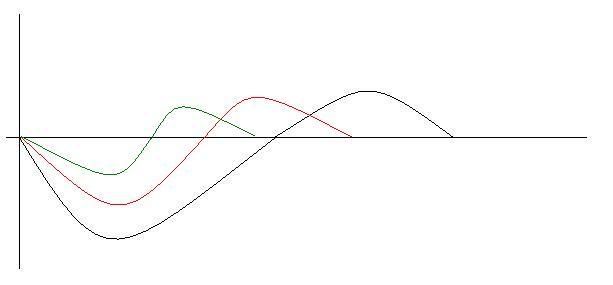
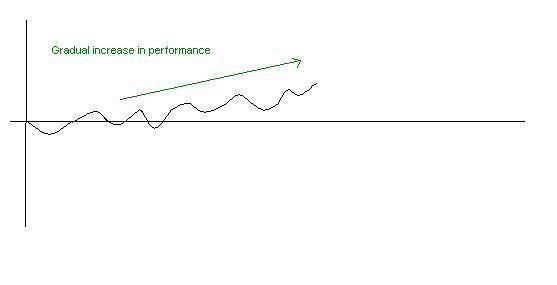








 )
)


Bookmarks